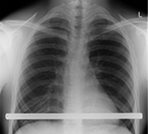Pectus excavatum myths busted by Mayo’s Christopher Moir, M.D.

Christopher Moir, M.D.
Mayo Clinic is a leader in treatment innovation for pediatric pectus excavatum repair. Christopher Moir, M.D. (PHYS ’89), Division of Pediatric Surgery at Mayo Clinic in Rochester, wants to bust some myths about treatment for this congenital birth defect.
-
Myth #1
“Surgical repair of pectus excavatum is a huge, invasive operation requiring a large incision; muscle, bone and cartilage damage; fracture and rewiring of the sternum; blood loss and possible transfusion; and a potential chest tube and bilateral drains.”
At a high-volume center such as Mayo Clinic, minimally invasive repair of pectus excavatum is the norm. Dr. Moir and his colleagues in the Mayo Clinic Children’s Center have performed more than 450 minimally invasive surgeries to repair pectus excavatum in pediatric patients since 1998. Mayo was the first in the Midwest to provide this type of surgery, which is performed with two small incisions and does not involve a sternal operation or damage to bone, muscle or cartilage.
Myth #2
“Pectus excavatum surgery patients can expect to be in pain for a very long time.”
Mayo Clinic has pioneered the use of ultrasound-guided paravertebral catheter blocks for pain control, which has proven to be very effective at controlling postsurgical pain. Pediatric patients have average pain scores of 3 out of 10 right after surgery. Patients get up the night of surgery, eat the night of surgery and walk the hallways the next day, according to Dr. Moir.
Myth #3
“Patients who have surgery to treat pectus excavatum stay have long hospital stays.”
The average hospital stay for pediatric patients who have minimally invasive surgery at Mayo Clinic is three days and is decreasing to two days.
Myth #4
“Surgery to treat pectus excavatum has no benefit other than cosmetic.”
Dr. Moir says there is clear evidence of cardiopulmonary benefit of repair to severe pectus excavatum deformities. “This is particularly important for teens who want to stay fit and be involved in sports. Prior to surgery, in our experience, these kids have a tough time keeping up with other kids, and they give up and take a seat on the couch. After surgery, they can’t believe how much better they do. They realize huge personal gains, which changes their outlook on their physical abilities and their mindset about lifelong wellness.”
Dr. Moir points out that this chest wall deformity is best treated in childhood, with a window of opportunity of 11 to 16 years of age. Dawn Jaroszewski, M.D. (S ’03), Department of Cardiovascular Surgery at Mayo Clinic in Arizona, performs surgical repair for adult patients with the condition.
Pectus carinatum
Another congenital defect, pectus carinatum, can be treated noninvasively, with bracing, in children who are still growing. Mayo Clinic soon will introduce a new type of wearable brace that is customized to each patient.
